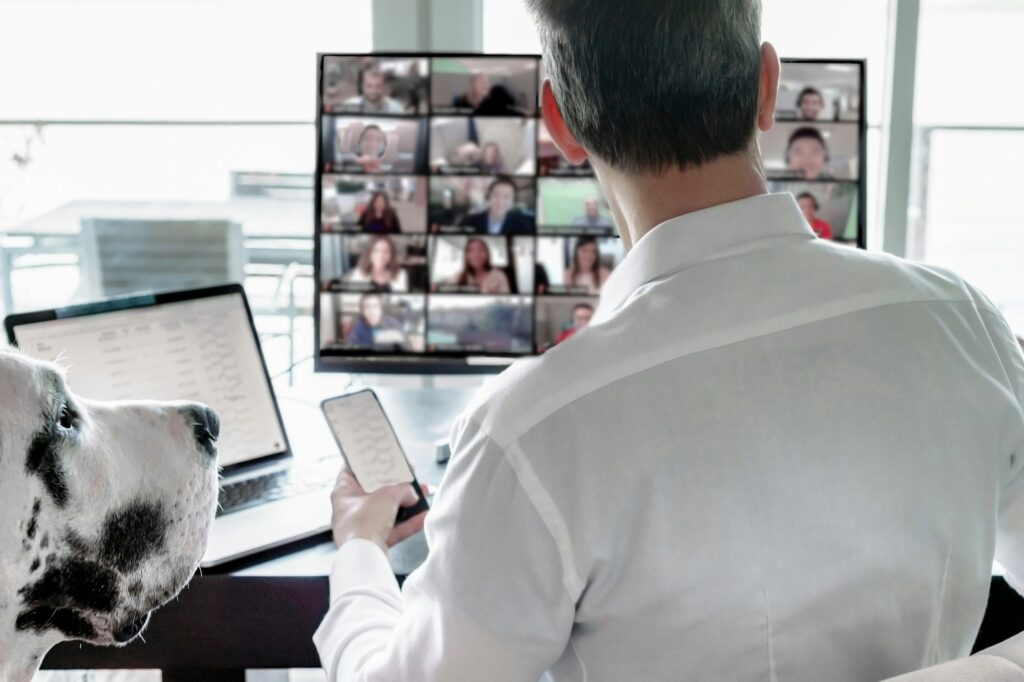
In today’s fast-paced, digitally connected world, managing virtual remote teams effectively can be both a challenge and an opportunity.
With more businesses embracing remote work, developing effective communication strategies is crucial for collaboration and productivity.
Whether your team is spread across different time zones or scattered in various locations, mastering the art of virtual communication can lead to a strong, cohesive team.
“Effective communication is 20% what you know and 80% how you feel about what you know.” — Jim Rohn

Effective communication is the foundation of a successful remote team. When your team is spread across different locations, ensuring clear and consistent communication becomes even more critical.
Here are some strategies to enhance communication within your remote team:
By incorporating these strategies, you can build a cohesive and efficient remote team, ready to tackle any challenge that comes your way.
Effective communication in remote work environments is a cornerstone for success. It plays a pivotal role in maintaining productivity, building team cohesion, and ensuring that everyone is on the same page.
Let’s explore some practical strategies to enhance communication in your virtual team.
First, embrace asynchronous communication tools. Platforms like Slack, Microsoft Teams, and email allow team members to communicate without needing to be online simultaneously.
This accommodates different time zones and work schedules, enabling team members to respond at their convenience while keeping the flow of information steady.
Next, invest in high-quality video conferencing tools. Programs such as Zoom, Google Meet, or Skype are excellent for real-time discussions, brainstorming sessions, and face-to-face encounters that help to strengthen relationships and build trust.
Ensure that all team members have reliable internet connections and suitable hardware to prevent technical issues from disrupting meetings.
Another crucial aspect is clear and concise messaging. In the absence of non-verbal cues, written communication should be direct and unambiguous.
Encourage your team to use bullet points, numbered lists, and headings to organize their thoughts and make the information easy to digest.
Also, don’t underestimate the power of regular updates and transparency. Use dashboards or project management tools like Trello, Asana, or Jira to keep everyone informed about project statuses, upcoming deadlines, and individual responsibilities.
This kind of transparency reduces the chances of misunderstandings and ensures accountability.
Moreover, establish routine check-ins. Regularly scheduled one-on-ones and team meetings provide opportunities for feedback, alignment, and social interaction, which are essential for team morale.
Use these meetings to discuss progress, share successes, and address any concerns that may arise.
Lastly, always be mindful of time zones. If your team spans multiple regions, make sure to schedule meetings at times that are convenient for everyone. Tools like World Time Buddy can help you find the best time slots.
By implementing these strategies, you can overcome the challenges of remote work and foster a more cohesive, productive, and engaged virtual team.
Building trust among remote team members isn’t just a lofty goal—it’s a necessity. Transparent communication serves as the bedrock of trust.
When you ensure that information flows freely and openly, you create an environment where team members feel valued and confident in their roles.
Start with Openness: Share project updates, challenges, and successes with your team. This not only keeps everyone on the same page but also fosters a culture of honesty and mutual respect.
When team members are aware of both the good and the bad, they can contribute to solutions and celebrate victories together.
Establish Clear Channels: Utilize reliable communication tools that support transparency.
Whether it’s Slack for daily messaging, Zoom for face-to-face meetings, or project management tools like Trello, ensure everyone knows where to find the information they need.

This minimizes the risk of miscommunication and ensures that all team members have equal access to critical updates.
Encourage Open Dialogue: Make it clear that every voice matters. Encourage team members to share their thoughts, ask questions, and express concerns without fear of judgment.
This can be achieved through regular team meetings, anonymous feedback forms, or one-on-one check-ins. When everyone feels heard, they are more likely to trust and engage with the team.
Lead by Example: As a leader, your approach to communication sets the tone for the entire team. Be transparent in your actions and words.
Admit mistakes openly, give credit where it’s due, and be clear about your expectations and visions for the team. Leading with transparency not only builds trust but also inspires your team to do the same.
Remember, trust isn’t built overnight. It’s a continuous process of open and honest communication. By prioritizing transparency, you lay the foundation for a cohesive, motivated, and trusting remote team.
Video conferencing tools have become the backbone of remote communication, empowering teams to collaborate effectively despite geographical barriers.
To make the most out of these tools, always start by setting a clear agenda before every meeting. This not only ensures that everyone is on the same page but also helps keep the discussion focused and productive.
Share the agenda well in advance, and make sure all participants are aware of the topics to be covered.
Choosing a reliable video conferencing platform is crucial. Tools like Zoom, Google Meet, and Microsoft Teams have become industry standards because of their user-friendly interfaces and robust features.
Look for features such as screen sharing, breakout rooms, and real-time collaboration options to enhance the meeting experience.
Always test your equipment and internet before the meeting starts to avoid technical difficulties that can disrupt the flow of conversation.
Encourage the use of cameras during meetings, as visual cues play a significant role in communication. Seeing each other’s facial expressions and body language makes the interaction more personal and engaging.
However, always respect privacy and allow team members to opt-out if they are not comfortable being on camera.
Additionally, establish norms for virtual meetings. Request participants to mute their microphones when not speaking to minimize background noise. Encourage attentive listening and active participation.
Although virtual meetings can sometimes feel less formal, maintaining a level of professionalism helps keep the sessions productive.
Finally, allocate time at the end of the meeting for questions and feedback. This promotes open dialogue and ensures that everyone leaves the meeting with a clear understanding of the next steps.
Regularly seeking feedback on the meeting format and content can help you continuously improve the effectiveness of your virtual meetings.

Imagine being left in the dark about how you’re performing at work. Not a pleasant thought, right? Regular check-ins and feedback sessions bridge this gap, providing your team with essential guidance and assurance.
Consistency is Key: Set up a routine for these interactions. Whether it’s a weekly catch-up or a monthly review, consistency ensures that team members know when to expect feedback and support.
This regularity can significantly reduce remote work anxieties.
Two-Way Street: Effective feedback should go both ways. Not only should you offer constructive criticism and praise, but you should also be open to receiving input from your team.
After all, they might have insights that can improve the workflow or highlight unrecognized issues.
Goal-Oriented Conversations: Keep check-ins focused on progress towards goals. Use these moments to celebrate achievements, discuss challenges, and set new targets. This not only keeps everyone aligned but also drives motivation.
Personal Touch: While it’s important to discuss work, don’t neglect the human side of things. Show genuine interest in your team members’ well-being.
Asking about their personal lives or how they’re coping with remote work creates a stronger, more empathetic connection.
By prioritizing regular check-ins and feedback, you’re not just addressing work performance—you’re nurturing a supportive and communicative team culture. This ultimately leads to higher productivity and enhanced job satisfaction.
When it comes to virtual teams, establishing clear communication norms and etiquette is essential. This involves setting expectations for how, when, and where communication should occur.
By doing so, you create an environment where misunderstandings are minimized, and team members feel more confident about how to interact with each other.
Define Communication Channels: Specify which communication tools should be used for different types of communication.
For instance, use instant messaging platforms like Slack for quick queries or updates, and reserve emails for more formal or detailed information.
Set Response Time Expectations: Clarify the expected response times for each communication channel. For example, team members might be expected to respond to instant messages within an hour but emails within 24 hours.
This helps manage expectations and ensures that important communications are not overlooked.
Respect Time Zones: Virtual teams often span multiple time zones. Create a shared calendar that highlights the working hours of each team member and use scheduling tools to find meeting times that work for everyone.
Respect off-hours communication boundaries to avoid burnout and ensure your team remains productive.
Establish Meeting Protocols: Set norms for virtual meetings such as punctuality, muting microphones when not speaking, and using video to maintain a personal connection.
Additionally, send out an agenda beforehand to ensure everyone is prepared and stays on topic during the meeting.
Encourage Inclusivity: Make sure every voice is heard by inviting input from all team members, especially those who might be less vocal. This can be facilitated by rotating the role of meeting chairperson or using tools that allow anonymous input.
Create a Shared Language: To overcome cultural and linguistic barriers, agree on a common language for communication. This ensures that all team members, regardless of their background, can understand and engage with the content.
Implementing these communication norms and etiquette guidelines can significantly enhance the efficiency and harmony of your virtual team. It’s all about creating a structured yet flexible framework that everyone can follow.
To create a forward-thinking remote team, prioritize ongoing development. Encourage your team to participate in webinars, online courses, and professional development workshops.
Helping your team to stay abreast of industry trends not only enhances their skill sets but also fosters a sense of personal growth and contribution.
Implement a Knowledge Sharing Culture. Virtual teams can establish dedicated channels on platforms like Slack or Microsoft Teams where members can share articles, insights, and useful resources.
Encourage everyone to contribute and actively engage with shared content. This cultivates an environment where continuous learning is a norm rather than an exception.
Moreover, mentorship programs can play a crucial role. Pairing less experienced team members with seasoned professionals within the company ensures knowledge transfer and nurtures a collaborative learning atmosphere.
Mentorship can be a great way to build relationships and trust among remote team members, leading to better communication and stronger team dynamics.
Lastly, regular feedback and reflection sessions are indispensable. Use these sessions to discuss what worked well and identify areas for improvement.
Encouraging open dialogue about successes and failures can lead to valuable lessons and innovative solutions. This process not only drives continuous improvement but also strengthens team cohesion.

When it comes to virtual teams, effective communication is paramount. It’s not just about sharing information; it’s about connecting with team members on a deeper level to build trust, collaboration, and a sense of belonging.
Here’s how you can elevate your virtual communication game:
1. Leverage Technology: Use the best communication technologies at your disposal. Platforms like Slack, Microsoft Teams, and Zoom can facilitate real-time interactions and file sharing, making remote collaboration seamless.
2. Embrace Video Calls: Video conferencing tools are more than just face-to-face substitutes. They enhance engagement, allowing for visual cues and expressions that are often lost in text-based communication.
3. Respect Time Differences: In a global team, respecting and understanding time zones can greatly enhance cooperation and goodwill. Use scheduling tools to find overlapping time slots that accommodate everyone.
4. Set Communication Norms: Establish clear etiquette and norms for virtual interactions. This includes defining response times, preferred communication channels, and meeting protocols to ensure everyone is on the same page.
5. Get Personal: Don’t shy away from personal interactions. Virtual coffee breaks and casual chats can help build personal connections, fostering a more cohesive and supportive team environment.
By implementing these strategies, you can enhance the effectiveness of your virtual communication and ensure your remote team operates smoothly and efficiently. Remember, the goal is not just to communicate, but to connect.
Remote work comes with its unique set of communication challenges. One significant issue is misunderstandings due to lack of context, as non-verbal cues like body language and tone can be hard to interpret through text.
Another challenge is the feeling of isolation that remote workers might experience, which can lead to decreased morale and engagement.
Additionally, time zone differences can complicate synchronous communication, making it difficult to schedule meetings and collaborate in real-time.
To keep remote teams engaged and connected, it’s crucial to foster a sense of community and inclusion.
Start by organizing regular virtual meetups and team-building activities that allow team members to interact informally.
Encouraging the use of instant messaging apps for daily communication can also help maintain a steady flow of information and interaction.
Additionally, implementing a system of recognition and rewards can boost morale and keep the team motivated.
Leaders can foster better communication in virtual teams by setting clear communication norms and expectations.
This includes specifying preferred communication channels for different types of messages and establishing guidelines for response times. Leveraging video conferencing tools for important discussions can also enhance clarity and understanding.
Additionally, leaders should schedule regular check-ins to provide feedback and address any concerns, ensuring team members feel heard and supported.
Improving non-verbal communication in virtual teams involves maximizing the use of video calls, where facial expressions and body language are more visible.
Encourage team members to turn on their video cameras during meetings to capture these non-verbal cues. Additionally, using emojis and GIFs in instant messaging can help convey emotions and lighten the tone of text-based communication.
Providing training on effective virtual communication can also help team members become more adept at expressing themselves clearly.
Asynchronous communication can be highly effective for remote teams when used correctly.
Start by leveraging tools like project management software (e.g., Trello, Asana) that allow team members to track progress and share updates without needing to meet in real-time.
Clear and detailed documentation, such as shared notes or wikis, can ensure everyone has access to necessary information.
Setting expectations for response times and being mindful of time zones can also help in making asynchronous communication more seamless and productive.
By implementing these strategies, you’re well on your way to creating a highly communicative and cohesive virtual team. Effective communication isn’t just a nice-to-have; it’s the backbone of any successful remote working environment.
From utilizing the right tools to establishing clear norms and fostering continuous learning, each step you take builds a stronger, more connected team.
Don’t forget, the key to excellent virtual communication lies in consistency and adaptability. Regular check-ins, transparent communication, and ongoing team-building activities are essential.
Also, don’t underestimate the power of giving and receiving feedback. It not only boosts team morale but also identifies any gaps in communication promptly.
Remember, the efforts you put in today to improve your team’s communication can lead to significant long-term benefits.
So, go ahead—inject some human connection into your virtual interactions and watch your team thrive even across the digital divide.



